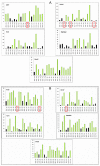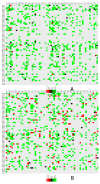Codon Usage and Context Analysis of Genes Modulated during SARS-CoV-2 Infection and Dental Inflammation
- PMID: 36366382
- PMCID: PMC9695912
- DOI: 10.3390/vaccines10111874
Codon Usage and Context Analysis of Genes Modulated during SARS-CoV-2 Infection and Dental Inflammation
Abstract
The overexpression of SARS-CoV-2 primary receptors and co-receptors (ACE2, TMPRSS2, FURIN, and CD147) enhance the likeliness of SARS-CoV-2 infection. The genes for same receptors are overexpressed in the periodontal tissues of periodontitis patients. On the other hand, BMAL1 is recognized to play a crucial role in regulating pulmonary inflammation and enhancing susceptibility to viral infection. Silenced BMAL1 disrupts circadian transcriptional regulations, enhances vulnerability to SARS-CoV-2 infections, and may trigger the further production of TNF-α and other pro-inflammatory cytokines that propagate the cytokine storm and exacerbate periodontal inflammation. Therefore ACE2, TMPRSS2, FURIN, CD147, and BMAL1 are the crossroads between SARS-CoV-2 and Periodontitis genes. The enhanced expression of ACE2, TMPRSS2, FURIN, and CD147 and the diminished expression of BMAL1 may be a strategy to check both ailments simultaneously. In gene manipulation techniques, oligos are introduced, which contain all the necessary information to manipulate gene expression. The data are derived from the studies on genes' molecular patterns, including nucleotide composition, dinucleotide patterns, relative synonymous codon usage, codon usage bias, codon context, and rare and abundant codons. Such information may be used to manipulate the overexpression and underexpression of the genes at the time of SARS-CoV-2 infection and periodontitis to mitigate both ailments simultaneously; it can be explored to uncover possible future treatments.
Keywords: ACE2; BMAL1; CD147; FURIN; SARS-CoV-2; TMPRSS2; codon context; dental; periodontitis; rare codons.
Conflict of interest statement
The authors declare no conflict of interest.
Figures








Similar articles
-
Periodontitis and COVID-19: Biological Mechanisms and Meta-analyses of Epidemiological Evidence.J Dent Res. 2022 Nov;101(12):1430-1440. doi: 10.1177/00220345221104725. Epub 2022 Jun 30. J Dent Res. 2022. PMID: 35774019 Review.
-
Distinctive Roles of Furin and TMPRSS2 in SARS-CoV-2 Infectivity.J Virol. 2022 Apr 27;96(8):e0012822. doi: 10.1128/jvi.00128-22. Epub 2022 Mar 28. J Virol. 2022. PMID: 35343766 Free PMC article.
-
Structural variations and expression profiles of the SARS-CoV-2 host invasion genes in lung cancer.J Med Virol. 2020 Nov;92(11):2637-2647. doi: 10.1002/jmv.26107. Epub 2020 Jun 19. J Med Virol. 2020. PMID: 32492203 Free PMC article.
-
Term Human Placental Trophoblasts Express SARS-CoV-2 Entry Factors ACE2, TMPRSS2, and Furin.mSphere. 2021 Apr 14;6(2):e00250-21. doi: 10.1128/mSphere.00250-21. mSphere. 2021. PMID: 33853873 Free PMC article.
-
Polymorphisms and mutations of ACE2 and TMPRSS2 genes are associated with COVID-19: a systematic review.Eur J Med Res. 2022 Feb 22;27(1):26. doi: 10.1186/s40001-022-00647-6. Eur J Med Res. 2022. PMID: 35193695 Free PMC article.
Cited by
-
Blockchain enabled collective and combined deep learning framework for COVID19 diagnosis.Sci Rep. 2025 May 13;15(1):16527. doi: 10.1038/s41598-025-00252-7. Sci Rep. 2025. PMID: 40360521 Free PMC article.
-
Insights into Synonymous Codon Usage Bias in Hepatitis C Virus and Its Adaptation to Hosts.Pathogens. 2023 Feb 15;12(2):325. doi: 10.3390/pathogens12020325. Pathogens. 2023. PMID: 36839597 Free PMC article.
-
Impact of Toll-Like Receptor 2 and 9 Gene Polymorphisms on COVID-19: Susceptibility, Severity, and Thrombosis.J Inflamm Res. 2023 Feb 17;16:665-675. doi: 10.2147/JIR.S394927. eCollection 2023. J Inflamm Res. 2023. PMID: 36825132 Free PMC article.
-
Significant association between asthma and a lower risk of mortality among COVID-19 patients in Spain: A meta-analysis.Qatar Med J. 2024 Jul 4;2024(3):34. doi: 10.5339/qmj.2024.34. eCollection 2024. Qatar Med J. 2024. PMID: 39040991 Free PMC article. Review.
References
-
- Glowacka I., Bertram S., Müller M.A., Allen P., Soilleux E., Pfefferle S., Steffen I., Tsegaye T.S., He Y., Gnirss K., et al. Evidence that TMPRSS2 activates the severe acute respiratory syndrome coronavirus spike protein for membrane fusion and reduces viral control by the humoral immune response. J. Virol. 2011;85:4122–4134. doi: 10.1128/JVI.02232-10. - DOI - PMC - PubMed
LinkOut - more resources
Full Text Sources
Miscellaneous

